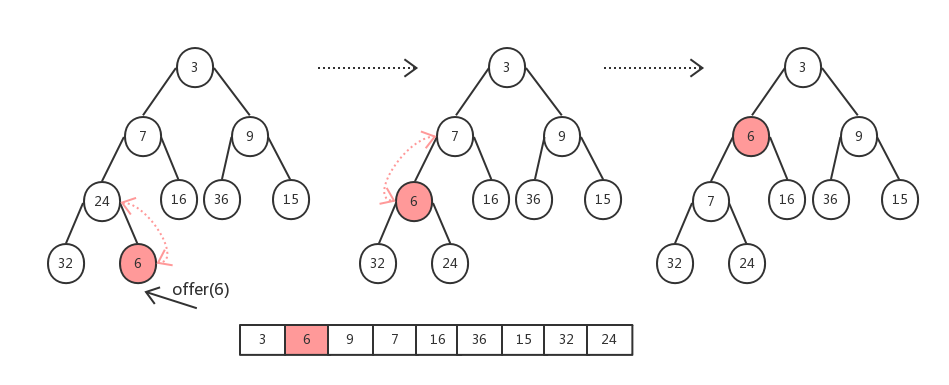在看这篇总结之前,建议大家先熟悉一下 PriorityQueue,这里主要介绍 PriorityBlockingQueue 一些特殊的性质,关于优先级队列的知识不作着重介绍,因为过程与 PriorityQueue 都是一致的。
关于 PriorityQueue 的文章,你可以参考这里->点击前往~
PriorityBlockingQueue 相关源码分析
add 方法
public boolean add(E e) {
return offer(e);
}
add 方法主要调用的是 offer 方法,下面我们来看 offer 方法。
public boolean offer(E e) {
// 队列所有的元素不允许为 null
if (e == null)
throw new NullPointerException();
final ReentrantLock lock = this.lock;
// 加锁
lock.lock();
int n, cap;
Object[] array;
// 判断是否需要扩容
while ((n = size) >= (cap = (array = queue).length))
tryGrow(array, cap);
try {
Comparator<? super E> cmp = comparator;
// 如果不自定义比较器,则默认为一个小顶堆,从下往上判断进行调整
if (cmp == null)
siftUpComparable(n, e, array);
else
siftUpUsingComparator(n, e, array, cmp);
size = n + 1;
// 唤醒非空条件对象
notEmpty.signal();
} finally {
// 释放锁
lock.unlock();
}
return true;
}
offer 方法整体的流程并不是复杂,首先加锁,然后判断是否需要扩容,接着添加元素,添加元素也分了两种情况,一种是没有自定义比较器,默认是小顶堆,如果初始化了自定义比较器,则按照自定义比较器的逻辑添加元素,因为添加了元素,队列肯定不为空,因此要唤醒 notEmpty 条件。
我们以不自定义比较器为例,看一下 siftUpComparable 方法是如何调整堆结构的。
private static <T> void siftUpComparable(int k, T x, Object[] array) {
Comparable<? super T> key = (Comparable<? super T>) x;
while (k > 0) {
int parent = (k - 1) >>> 1;
Object e = array[parent];
if (key.compareTo((T) e) >= 0)
break;
array[k] = e;
k = parent;
}
array[k] = key;
}
siftUpComparable 方法与 PriorityQueue 中对应的方法简直是一模一样,放一张图在这,就不具体介绍了。

其中比较有意思的是 tryGrow 扩容方法,我们接下来看一下这个方法。
/**
* Q:扩容操作为什么要允许多个线程进来呢?
* A:如果整个扩容过程还加锁的话,其他线程是不能修改队列的,
* 只能等待扩容完后才能继续执行,并发效率比较低
*/
private void tryGrow(Object[] array, int oldCap) {
// 释放锁
lock.unlock(); // must release and then re-acquire main lock
Object[] newArray = null;
/**
* compareAndSwapInt:
*
* this:当前对象的引用
* allocationSpinLockOffset:allocationSpinLock 在内存中的偏移量
* 0:allocationSpinLock 的预期值
* 1:更新值
*/
if (allocationSpinLock == 0 && UNSAFE.compareAndSwapInt(this, allocationSpinLockOffset, 0, 1)) {
try {
// 当容量小于 64 时容量为原来的两倍 + 2,如果大于等于 64 时扩容为原来的 1.5 倍
// 与 PriorityQueue 一致
int newCap = oldCap + ((oldCap < 64) ?
(oldCap + 2) : // grow faster if small
(oldCap >> 1));
if (newCap - MAX_ARRAY_SIZE > 0) { // possible overflow
int minCap = oldCap + 1;
if (minCap < 0 || minCap > MAX_ARRAY_SIZE)
throw new OutOfMemoryError();
newCap = MAX_ARRAY_SIZE;
}
// 初始化新的数组
if (newCap > oldCap && queue == array)
newArray = new Object[newCap];
} finally {
// allocationSpinLock 置 0
// 因此后面的线程获取锁也可能会尝试 CAS 成功,然后初始化新数组
allocationSpinLock = 0;
}
}
/**
* 如果当前线程尝试 CAS 失败,则尝试让步
* Q:这里为什么要让步?
* A:因为自己不是成功初始化新数组的线程,就算获取到了线程也不能正确扩容,
* 因此让步尽量让成功扩容的线程获取锁
*/
if (newArray == null) // back off if another thread is allocating
Thread.yield();
/**
* Q:在加锁之前,可能由多个数组尝试 CAS 成功,且成功的初始化了新的数组,
* 那么是不是后面的新数组会覆盖前面的数组呢?
* A:当然答案肯定是不会的,那么是如何保证正确性的呢?关键在于 queue == array 判断,
* 因此只有第一个判断成功的线程能正确扩容,其他非第一个线程再进行判断的时候会返回 false,
* 自然不会进行数组元素拷贝
*/
lock.lock();
if (newArray != null && queue == array) {
// 重置队列内部数组
queue = newArray;
// 元素拷贝,同 PriorityQueue
System.arraycopy(array, 0, newArray, 0, oldCap);
}
}
这个方法比较特殊的地方在于先释放了锁,然后通过 CAS 操作判断是否需要初始化新数组,尝试 CAS 失败的线程,会做出一个让步,放弃 CPU 时间片,然后与其他线程一同竞争。这个过程我们可以思考以下几个问题:
- 为什么不直接加锁而是通过 CAS 加判断操作完成扩容步骤
- 为什么尝试 CAS 失败的线程需要让步
- 在多线程情况下可能会有多个线程初始化新数组,那如何保证操作一致性
这些问题在上面的方法里都总结了一些自己的想法,如果大家有不同的见解可以留言交流。
take 方法
public E take() throws InterruptedException {
final ReentrantLock lock = this.lock;
// 加锁(可响应中断)
lock.lockInterruptibly();
E result;
try {
// 如果队列为空,take 方法会阻塞出队线程
while ( (result = dequeue()) == null)
/**
* 如果队列中没有元素,会阻塞后续调用 take 方法出队的线程
* 直到队列添加了元素后唤醒 notEmpty,才可以继续执行
*/
notEmpty.await();
} finally {
// 释放锁
lock.unlock();
}
return result;
}
take 方法中调用了 dequeue 方法,如下:
private E dequeue() {
int n = size - 1;
if (n < 0)
return null;
else {
Object[] array = queue;
// 堆顶的元素
E result = (E) array[0];
// 堆最底层的元素(最后一个)
E x = (E) array[n];
// 把最后一个元素置 null,因为要把它放到堆顶,向下逐步调整堆结构,与 PriorityQueue 一致
array[n] = null;
Comparator<? super E> cmp = comparator;
if (cmp == null)
siftDownComparable(0, x, array, n);
else
siftDownUsingComparator(0, x, array, n, cmp);
size = n;
return result;
}
}
我们还以不自定义比较器为例,看下 siftDownComparable 方法。
private static <T> void siftDownComparable(int k, T x, Object[] array,
int n) {
if (n > 0) {
Comparable<? super T> key = (Comparable<? super T>)x;
int half = n >>> 1; // loop while a non-leaf
while (k < half) {
int child = (k << 1) + 1; // assume left child is least
Object c = array[child];
int right = child + 1;
if (right < n &&
((Comparable<? super T>) c).compareTo((T) array[right]) > 0)
c = array[child = right];
if (key.compareTo((T) c) <= 0)
break;
array[k] = c;
k = child;
}
array[k] = key;
}
}
过程与 ProrityQueue 还是一样的,就不分析了,放一张图帮助大家理解吧。

(完)